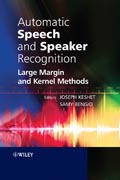
Automatic speech and speaker recognition: Large Margin and Kernel methods
Keshet, Joseph
A key resource for machine learning and speech recognition researchers and engineers, Large Margin and Kernel Methods for Speech Recognition unites research related to speech and speaker recognition based on recent advances in large margin and kernel methods. The first part of the book presents theoretical andpractical foundations, from support vector machines to large margin methods for structured learning. The second part is dedicated to acoustic modeling of continuous speech recognizers. The third part introduces large margin methods for discriminative language modeling. The last part of the book discusses applications of speaker verification and identification. INDICE: List of Contributors. Preface. I Foundations. 1 Introduction (SamyBengio and Joseph Keshet). 1.1 The Traditional Approach to Speech Processing.1.2 Potential Problems of the Probabilistic Approach. 1.3 Support Vector Machines for Binary Classification. 1.4 Outline. References. 2 Theory and Practiceof Support Vector Machines Optimization (Shai Shalev-Shwartz and Nathan Srebo). 2.1 Introduction. 2.2 SVM and L2-regularized Linear Prediction. 2.3 Optimization Accuracy >From a Machine Learning Perspective. 2.4 Stochastic Gradient Descent. 2.5 Dual Decomposition Methods. 2.5.1 Duality. 2.6 Summary. References. 3 From Binary Classification to Categorial Prediction (Koby Crammer). 3.1 Multi-category Problems. 3.2 Hypothesis Class. 3.3 Loss Functions. 3.4 Hinge Loss Functions. 3.5 A Generalized Perceptron Algorithm. 3.6 A Generalized PassiveAggressive Algorithm. 3.7 A Batch Formulation. 3.8 Concluding Remarks. 3.9 Appendix. Derivations of the Duals of the PassiveAggressive Algorithm and the Batch Formulation. References. II Acoustic Modeling. 4 A Large Margin Algorithm for Forced Alignment (Joseph Keshet, Shai Shalev-Shwartz, Yoram Singer and Dan Chazan). 4.1 Introduction. 4.2 Problem Setting. 4.3 Cost and Risk. 4.4 ALarge Margin Approach for Forced Alignment. 4.5 An Iterative Algorithm. 4.6 Efficient Evaluation of the Alignment Function. 4.7 Base Alignment Functions. 4.8 Experimental Results. 4.9 Discussion. References. 5 A Kernel Wrapper for Phoneme Sequence Recognition (Joseph Keshet and Dan Chazan). 5.1 Introduction. 5.2 Problem Setting. 5.3 Frame-based Phoneme Classifier. 5.4 Kernel-based Iterative Algorithm for Phoneme Recognition. 5.5 Nonlinear Feature Functions. 5.6 Preliminary Experimental Results. 5.7 Discussion: Canwe Hope for Better Results? References. 6 Augmented Statistical Models: Using Dynamic Kernels for Acoustic Models (Mark J. F. Gales). 6.1 Introduction. 6.2 Temporal Correlation Modeling. 6.3 Dynamic Kernels. 6.4 Augmented Statistical Models. 6.5 Experimental Results.6.6 Conclusions. Acknowledgements. References. 7 Large Margin Training of Continuous Density Hidden Markov Models (Fei Sha and Lawrence K. Saul). 7.1 Introduction. 7.2 Background. 7.3 Large Margin Training. 7.4 Experimental Results. 7.5 Conclusion. References. III Language Modeling. 8 A Survey of Discriminative Language Modeling Approaches for Large Vocabulary Continuous Speech Recognition (Brian Roark). 8.1 Introduction. 8.2 General Framework. 8.3 Further Developments. 8.4 Summary and Discussion. References. 9 Large Margin Methods for Part-of-Speech Tagging (Yasemin Altun). 9.1 Introduction. 9.2 Modeling Sequence Labeling. 9.3 Sequence Boosting. 9.4 Hidden Markov Support Vector Machines. 9.5Experiments. 9.6 Discussion. References. 10 A Proposal for a Kernel Based Algorithm for Large Vocabulary Continuous Speech Recognition (Joseph Keshet). 10.1 Introduction. 10.2 Segment Models and Hidden Markov Models. 10.3 Kernel Based Model. 10.4 Large Margin Training. 10.5 Implementation Details. 10.6 Discussion. Acknowledgements. References. IV Applications. 11 Discriminative Keyword Spotting (David Grangier, Joseph Keshet and Samy Bengio). 11.1 Introduction. 11.2 PreviousWork. 11.3 Discriminative Keyword Spotting. 11.4 Experiments and Results. 11.5 Conclusions. Acknowledgements. References. 12 Kernel-based Text-independent Speaker Verification (Johnny Mariéthoz, Samy Bengio and Yves Grandvalet). 12.1 Introduction. 12.2 Generative Approaches. 12.3 Discriminative Approaches. 12.4 Benchmarking Methodology. 12.5 Kernels for Speaker Verification. 12.6 Parameter Sharing. 12.7 Is the Margin Useful for This Problem? 12.8 Comparing all Methods. 12.9 Conclusion. References. 13 Spectral Clustering for Speech Separation (Francis R. Bach and Michael I. Jordan). 13.1 Introduction. 13.2Spectral Clustering and Normalized Cuts. 13.3 Cost Functions for Learning theSimilarity Matrix. 13.4 Algorithms for Learning the Similarity Matrix. 13.5 Speech Separation as Spectrogram Segmentation. 13.6 Spectral Clustering for Speech Separation. 13.7 Conclusions. References . Index.
- ISBN: 978-0-470-69683-5
- Editorial: John Wiley & Sons
- Encuadernacion: Cartoné
- Páginas: 268
- Fecha Publicación: 16/01/2009
- Nº Volúmenes: 1
- Idioma: Inglés
